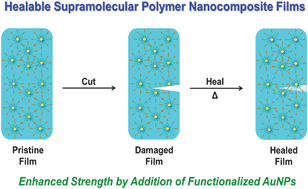Inspired by the success of polymer-composite materials in replacing metals across a range of high value products, Hayes and co-workers have investigated the possibility of producing nanoparticle-reinforced, supramolecular, healable composites. The material comprises a blend of three components: a pyrene-functionalized polyamide, a polydiimide and pyrene-functionalized gold nanoparticles (P-AuNPs). The polymeric components interact by forming well-defined π–π stacked complexes between π-electron rich pyrenyl residues and π-electron deficient polydiimide residues. Complexation studies in solution demonstrate that the introduction of P-AuNPs results in more rapid formation of an insoluble supramolecular network when compared to control samples that did not contain the P-AuNPs. Films of the nanocomposite are tough and flexible, and contain a relatively homogeneous dispersion of P-AuNPs. Films containing P-AuNPs are stronger and stiffer than those cast from the same polymers but without P-AuNPs, and also than films containing AuNPs that lacked the pyrenyl motif. Healing studies using a classic break/heal test, followed by stress–strain analysis, showed that materials containing up to 10 wt% P-AuNPs can even exhibit healing efficiencies of more than 100%.
Molecular recognition between functionalized gold nanoparticles and healable, supramolecular polymer blends – a route to property enhancement by Rajendran Vaiyapuri, Barnaby W. Greenland, Howard M. Colquhoun, Joanne M. Elliott and Wayne Hayes, Polym. Chem. 2013, 4, 4902-4909.
Julien Nicolas is a guest web-writer and advisory board member for Polymer Chemistry. He currently works at Univ. Paris-Sud (FR) as a CNRS researcher.











